|
| |
2012 Widescreen Weekend Program
Pictureville, Bradford, England | Read more at
in70mm.com
The 70mm Newsletter
| | Text and images by:
- | Date:
01.02.2012. Updated
22-01-25 |
Friday 27.04.2012
|
|
"Cinerama’s Russian Adventure" 10:00
|
|
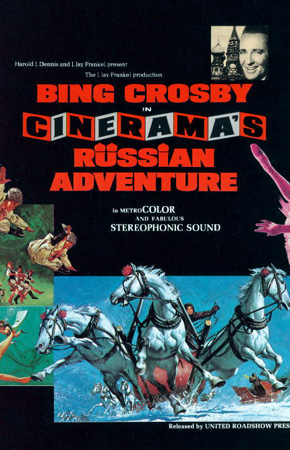 10:00 – 12:22 “Cinerama's
Russian Adventure”
(2:07) + 15 min intermission.
Filmed in:
3x35mm 6 perforations, 24 frames per second.
Principal photography in:
Sovcolor 3-strip Kinopanorama. Presented on:
The curve in Kinopanorama. Smileboxed and remastered with 5.1 digital stereo.
Angle of view:
146°. Country of origin: USSR.
Originally released March 29, 1966 in Chicago.
Later optically printed to 70mm. 10:00 – 12:22 “Cinerama's
Russian Adventure”
(2:07) + 15 min intermission.
Filmed in:
3x35mm 6 perforations, 24 frames per second.
Principal photography in:
Sovcolor 3-strip Kinopanorama. Presented on:
The curve in Kinopanorama. Smileboxed and remastered with 5.1 digital stereo.
Angle of view:
146°. Country of origin: USSR.
Originally released March 29, 1966 in Chicago.
Later optically printed to 70mm.
Included sequences from:
Great is my Country 28.02.1958
The Enchanted Mirror 1958
One hour of Unexpected Travels by Helicopter 1960
Fourth Programme of Panorama Films: "Circus Performance " and "On the Red Square" 1961
Naughty Curves 1961
With an Open Heart 1961
To the Antarctic for the Whales 1961
Amazing Hunting 1962
The Volga Flows On 1963
Introduced by Randy Gitsch and Dave Strohmaier
Update on remastered "Cinerama's Russian Adventure"
|
Orphan
Films Discovered in Hollywood Basement
|
in70mm.com's Cinerama page
|
More in 70mm reading:
Widescreen Weekend 2012
•
Gallery:
2012
•
Mission
Report
• WSW Home
• Through the Years
• The Best of WSW
•
Academy of the WSW
•
Creating the WSW
•
Planning the WSW
• Projecting
the WSW
•
Home of
CINERAMA
•
Projecting CINERAMA
|
"The Windjammer Voyage: a Cinemiracle Adventure" - 12:45
- World Premiere showing
|
|
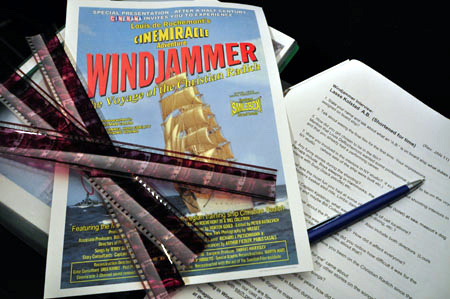 12:45
"The Windjammer Voyage: a Cinemiracle Adventure"
(0:56) Presented on:
The flat screen. Country of origin: USA/Australia/Norway. Production year:
2011.
World Premiere: 27.04.2012, Pictureville Cinema, Bradford, UK 12:45
"The Windjammer Voyage: a Cinemiracle Adventure"
(0:56) Presented on:
The flat screen. Country of origin: USA/Australia/Norway. Production year:
2011.
World Premiere: 27.04.2012, Pictureville Cinema, Bradford, UK
"The Windjammer Voyage: a Cinemiracle Adventure" is a 56 minute
documentary starring members of the cast and crew of the Cinemiracle
film "Windjammer". Filmed in Norway and Australia in January 2011, crew
and cadets share their incredible stories about of the voyage, the
filming and what happened to them in the years that followed. Featuring
never before seen behind the scenes photos of the voyage and rare home
movies taken during the production. The film
"Windjammer" was hugely successful in 1958-60 almost all over the
world. Largely unseen since the original release, the "lost" film about
a Norwegian school ship, has undergone a digital remastering process for
theatrical presentation and DVD/Blu-ray release.
Credits: Produced and Edited by David Strohmaier. Interviews
conducted by Thomas Hauerslev, Espen J. Jørgensen, John Steven Lasher.
Norwegian Producer Espen J. Jørgensen. Associate Producer in Norway
Thomas Hauerslev. Associate Producer in Australia John Steven Lasher.
Contributing Producer Randy Gitsch. Cinematography Morten Skallerud
(Norway) and Richard Monk (Australia). Special Thanks to Jan E. Olsen of
the Norwegian Film Institute and to Kaare Terland
Cast: Lasse Kolstad, Barbra Karine "Kari" Christensen, Kaare Terland,
Alf Bjerke, Kjell Grette Christensen, Jon Reistad, Tore Bilet, Turi
deRochemont, Jan Halvorsen, Sven Libaek, Jan E. Olsen & Thomas Hauerslev
"Windjammer" Cast & Crew
Interviews in Oslo
|
Composer & Movie Star Sven
Libaek interviewed
|
Sven Libaek's Autobiography -
Chapter 3 "WINDJAMMER"
Introduced by David Strohmaier
| |
"This is Cinerama" - 14:15
|
|
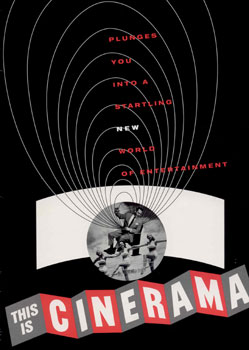  14:15 – 16:30 “This is Cinerama”
(2:00) + 15 min intermission.
Filmed in:
3x35mm 6 perforations, 26 frames per second.
Principal photography in: Cinerama. Presented on:
The curve in 3-strip Cinerama with 7-track magnetic stereo.
Angle of view:
146°. Country of origin: USA. Production year:
1952.
World Premiere: 30.09.1952 The Broadway Theatre, New York, USA. 14:15 – 16:30 “This is Cinerama”
(2:00) + 15 min intermission.
Filmed in:
3x35mm 6 perforations, 26 frames per second.
Principal photography in: Cinerama. Presented on:
The curve in 3-strip Cinerama with 7-track magnetic stereo.
Angle of view:
146°. Country of origin: USA. Production year:
1952.
World Premiere: 30.09.1952 The Broadway Theatre, New York, USA.
Developed by Fred Waller. Narrated by Lowell Thomas. Supervised by
Michael Todd and Michael Todd Jr. Produced by Merian C. Cooper and
Robert L. Bendick. Music by Cinerama Philharmonic Orchestra.
Cinematography by Harry Squire.
Print: National Media Museum
This is the original Cinerama feature which launched the widescreen era,
here presented in a recently struck print in the original three-strip
format, with seven-track stereo sound. There is no narrative, merely a
variety of 'attractions': the famous rollercoaster ride is followed by a
series of musical and travelogue episodes culminating in an aerial tour
of America. More than a technological curio, it's a document of its era.
|
Internet link:
Cinema Retro
National Media Museum
Reel Solutions
Tom March is a co sponsor of Grimm (Paid
for the new sound track)
Full Sponsor of the the This Is Cinerama "reprints" to update
Bradford's Print
Co Sponsor of South Seas Adventure (credited as co producer) on the
restoration credits
Full sponsor of the new print of the Renault Commercial - which
Bradford gets to keep the new print
Full Sponsor of "Precious Images" along with Chuck Workman of the HD
digital copy being donated to the Museum
|
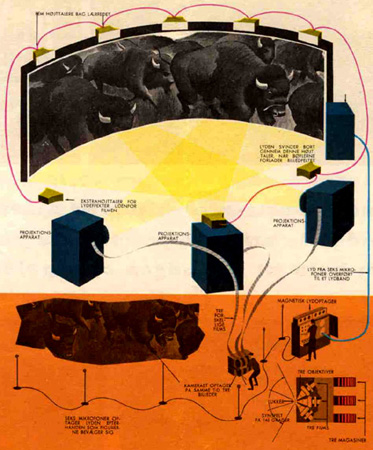 How
Cinerama works. 3 cameras photograph a scene on three separate side-by-side
films in a 146 degree panorama. In the cinema, all three films are shown
side-by-side on a curved screen. This creates a sense of depth and reality
unlike anything you have ever seen. If you have not seen Cinerama yet, then
this is your chance. How
Cinerama works. 3 cameras photograph a scene on three separate side-by-side
films in a 146 degree panorama. In the cinema, all three films are shown
side-by-side on a curved screen. This creates a sense of depth and reality
unlike anything you have ever seen. If you have not seen Cinerama yet, then
this is your chance.
1953 Academy Award Wins:
Fred Waller (d. May 18, 1954) for designing and developing the multiple photographic and projection systems which culminated in Cinerama.
Academy Award Nominated:
Best Music, Scoring of a Dramatic or Comedy
Picture
What is Cinerama?
Cinerama is a very complicated projection process with three projectors
electronically locked together, showing three 35mm films side by side on
the same curved screen, at the same time. Cinerama, very effectively
creates an illusion of reality, by photographing an extreme wide-angle
picture on three strips of film. Cinerama is shown on a large curved
screen like
Pictureville's. The curve is defined as being 146 degrees of a
circle. The screen is geometrically the same size as the human eye,
which when a spectator sits somewhere close to the center of the circle,
looking at the middle of the screen, he’s having A First Person
Experience. He’s having the sensation he is there, right in the
middle of the action. The audience will feel a sensation of
participation.
Why does a Cinerama screen have to be deeply curved?
”If you photograph a cavalry of horses coming toward you and sweeping
past, using conventional narrow angle lenses (and this includes
CinemaScope), the camera never sees the sides of the horses. If this is
now projected on a screen, even a wide curved one, wrapped around the
audience, as the horses go off the screen, they all turn facing you and
gallop sideways. This is a subtle effect, but the fact that you never
see the sides of objects, destroys the participation effect - the sense
of being in the middle of the action.”
Brian O'Brien,
Jr. about Cinerama
|
in70mm.com's Cinerama page
|
The Birth of an Idea
Introduced by Dave Strohmaier
and talk about the new replacement footage with Tom March
| |
Loren Janes Lecture: “How The West Was Won” behind the scenes 16:50
|
|
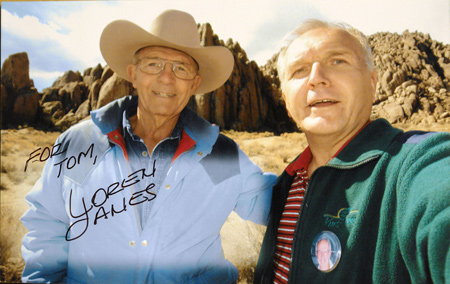 Loren
Janes with Tom March on the site where "How the West Was Won" was filmed. Image by Tom March Loren
Janes with Tom March on the site where "How the West Was Won" was filmed. Image by Tom March
Stuntman and Film Raconteur,
Loren Janes shows you
his personal film clips of his work on the epic Hollywood film "How
The West Was Won". He has been an icon in the stunt industry for
more than 50 years. The founder of the Stuntmen Association of Motion
Pictures and Television has spent a lifetime perfecting his skills and
thrilling audiences around the world. Loren will tell of those days and
the locations where his historic stunts were performed. Listen to his
reminiscences of when he worked along side numerous Hollywood stars
including Paul Newman, Steve McQueen, Jack Nicholson and Debbie
Reynolds. Loren shows you where he appears as a stunt double in ”How
The West Was Won” and where he appears in supporting roles so that
you can better appreciate his contribution to the film. He takes you on
an actual behind the scenes look at how his stunts were prepared to
create the action you will see on the big screen. Action movies would
seem very static were it not for performers like Loren Janes.
|
|
Widescreen Reception for weekend delegates
+ Academy of the Widescreen Weekend 18:00
|
|
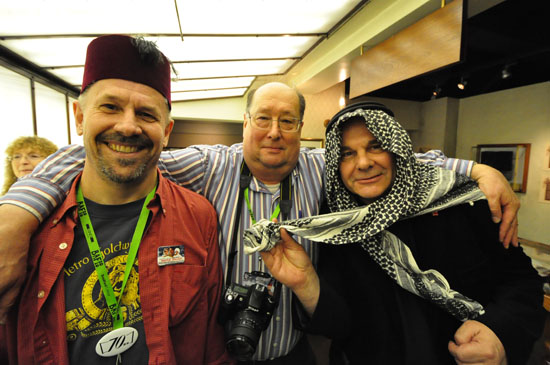 Reception
guests 2011 - the Russian, French, Arabian delegation. Sebastian
Rosacker (left) Francois Carrin and Mark Lyndon Reception
guests 2011 - the Russian, French, Arabian delegation. Sebastian
Rosacker (left) Francois Carrin and Mark Lyndon
|
|
"How the West Was Won" - The Cast
Remembers - 19:00
|
|
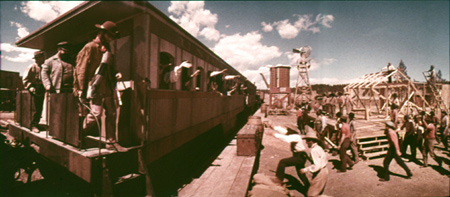 "Stars Debbie Reynolds, Carroll Baker, Russ Tamblyn and Eli Wallach, as
well as stuntman Loren James appear in a short potpourri of additional
interviews originally compiled as an intended value-added documentary
for the 2008 Warner Bros Home Video release of
"How the West Was Won".
"Stars Debbie Reynolds, Carroll Baker, Russ Tamblyn and Eli Wallach, as
well as stuntman Loren James appear in a short potpourri of additional
interviews originally compiled as an intended value-added documentary
for the 2008 Warner Bros Home Video release of
"How the West Was Won".
Introduced by Randy Gitsch
(20 min)
|
|
"How the West Was Won" - 19:30
|
|
 “How the West Was Won”
(2:42) + intermission.
Filmed in:
3x35mm 6 perforations, 24 frames per second.
Principal photography in: Cinerama. Presented:
On the curved
screen in
3-strip “How the West Was Won”
(2:42) + intermission.
Filmed in:
3x35mm 6 perforations, 24 frames per second.
Principal photography in: Cinerama. Presented:
On the curved
screen in
3-strip
 with 7 track
magnetic stereophonic sound.
Angle of view: 146°. Country of origin: USA. Production year:
1961.
World Premiere: 01.11.1962 Casino, London, England.
with 7 track
magnetic stereophonic sound.
Angle of view: 146°. Country of origin: USA. Production year:
1961.
World Premiere: 01.11.1962 Casino, London, England.
Written by James R. Webb. Produced by Bernard Smith. Original Music by
Ken Darby and Alfred Newman. Cinematography by William H. Daniels,
Milton R. Krasner, Charles Lang and Joseph LaShelle. Directed by John
Ford, Henry Hathaway and George Marshall.
Carroll Baker (Eve Prescott Rawlings), Lee J. Cobb (Marshal Lou Ramsey),
Henry Fonda (Jethro Stuart), Gregory Peck (Cleve Van Valen), Debbie
Reynolds (Lilith 'Lily' Prescott), James Stewart (Linus Rawlings), Eli
Wallach (Charlie Gant)
"How the
West Was Won"
Academy Award Wins:
Best Film Editing Harold F. Kress
Best Sound Franklin Milton (M-G-M SSD)
Best Writing, Story and Screenplay - Written Directly for the Screen, James
R. Webb
Academy Award Nominated:
Best Art Direction-Set Decoration, Color George W. Davis, William Ferrari,
Addison Hehr, Henry Grace, Don Greenwood Jr., Jack Mills
Best Cinematography, Color William H. Daniels, Milton R. Krasner, Charles
Lang, Joseph LaShelle
Best Costume Design, Color, Walter Plunkett
Best Music, Score - Substantially Original Alfred Newman, Ken Darby
Best Picture Bernard Smith
Youtube trailer
|
in70mm.com's Cinerama page |
Introducing "How the West
Was Won" in Digital in 2009
|
"How The
West Was Won" Cinerama Event at the Cinerama Dome
| |
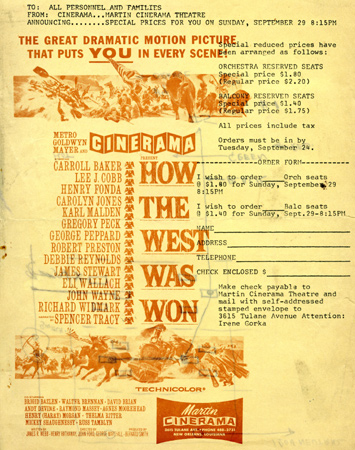 allmovie.com: Filmed in panoramic Cinerama, this star-studded, epic
Western adventure is a true cinematic classic. Three legendary directors
(Henry Hathaway, John Ford, and George Marshall) combine their skills to
tell the story of three families and their travels from the Erie Canal to
California between 1839 and 1889. Spencer Tracy narrates the film, which
cost an estimated 15 million dollars to complete. In the first segment, "The
Rivers," pioneer Zebulon Prescott (Karl Malden) sets out to settle in the
West with his wife (Agnes Moorehead) and their four children. Along with
other settlers and river pirates, they run into mountain man Linus Rawlings
(James Stewart), who sells animal hides. The Prescotts try to raft down the
Ohio River in a raft, but only daughters Lilith (Debbie Reynolds) and Eve
(Carroll Baker) survive. Eve and Linus get married, while Lilith continues
on. In the second segment, "The Plains," Lilith ends up singing in a saloon
in St. Louis, but she really wants to head west in a wagon train led by
Roger Morgan (Robert Preston). Along the way, she's accompanied by the
roguish gambler Cleve Van Valen (Gregory Peck), who claims he can protect
her. After he saves her life during an Indian attack, they get married and
move to San Francisco. In the third segment, "The Civil War," Eve and Linus'
son, Zeb (George Peppard), fights for the Union. After he's forced to kill
his Confederate friend, he returns home and gives the family farm to his
brother. In the fourth segment, "The Railroads," Zeb fights with his
railroad boss (Richard Widmark), who wants to cut straight through Indian
territory. Zeb's co-worker Jethro (Henry Fonda) refuses to cut through the
land, so he quits and moves to the mountains. After the railway camp is
destroyed, Zeb heads for the mountains to visit him. In the fifth segment,
"The Outlaws," Lilith is an old widow traveling from California to Arizona
to stay with her nephew Zeb on his ranch. However, he has to fight a gang of
desperadoes first. How the West Was Won garnered three Oscars, for
screenplay, film editing, and sound production. allmovie.com: Filmed in panoramic Cinerama, this star-studded, epic
Western adventure is a true cinematic classic. Three legendary directors
(Henry Hathaway, John Ford, and George Marshall) combine their skills to
tell the story of three families and their travels from the Erie Canal to
California between 1839 and 1889. Spencer Tracy narrates the film, which
cost an estimated 15 million dollars to complete. In the first segment, "The
Rivers," pioneer Zebulon Prescott (Karl Malden) sets out to settle in the
West with his wife (Agnes Moorehead) and their four children. Along with
other settlers and river pirates, they run into mountain man Linus Rawlings
(James Stewart), who sells animal hides. The Prescotts try to raft down the
Ohio River in a raft, but only daughters Lilith (Debbie Reynolds) and Eve
(Carroll Baker) survive. Eve and Linus get married, while Lilith continues
on. In the second segment, "The Plains," Lilith ends up singing in a saloon
in St. Louis, but she really wants to head west in a wagon train led by
Roger Morgan (Robert Preston). Along the way, she's accompanied by the
roguish gambler Cleve Van Valen (Gregory Peck), who claims he can protect
her. After he saves her life during an Indian attack, they get married and
move to San Francisco. In the third segment, "The Civil War," Eve and Linus'
son, Zeb (George Peppard), fights for the Union. After he's forced to kill
his Confederate friend, he returns home and gives the family farm to his
brother. In the fourth segment, "The Railroads," Zeb fights with his
railroad boss (Richard Widmark), who wants to cut straight through Indian
territory. Zeb's co-worker Jethro (Henry Fonda) refuses to cut through the
land, so he quits and moves to the mountains. After the railway camp is
destroyed, Zeb heads for the mountains to visit him. In the fifth segment,
"The Outlaws," Lilith is an old widow traveling from California to Arizona
to stay with her nephew Zeb on his ranch. However, he has to fight a gang of
desperadoes first. How the West Was Won garnered three Oscars, for
screenplay, film editing, and sound production.
|
|
Saturday 28.04.2011
|
|
Cinerama Update
by Randy Gitsch and Dave Strohmaier - 10:00
|
|
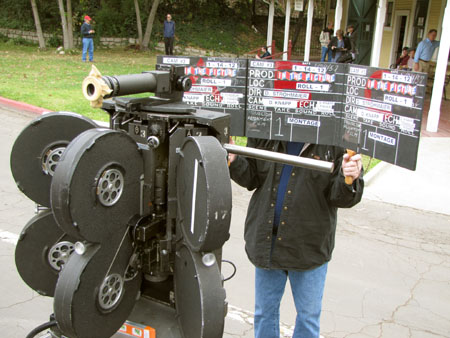 "What
is happening the world over in Cinerama in 2012 during the 60th
anniversary of the film format which started the widescreen revolution?
An entertaining look at the ever popular Cinerama format told by special
friends of the Widescreen Weekend, the Crusaders of 3-strip; Gitsch and
Strohmaier. "What
is happening the world over in Cinerama in 2012 during the 60th
anniversary of the film format which started the widescreen revolution?
An entertaining look at the ever popular Cinerama format told by special
friends of the Widescreen Weekend, the Crusaders of 3-strip; Gitsch and
Strohmaier.
The update - Sponsored by Cinerama, Inc. - will include information about
John Sittig, Mike Forman, Copyright issues,
Restoring "This Is Cinerama", Flicker Alley, "Windjammer",
"Holiday In Spain", "The Golden Head", "South Seas
Adventure", "Cinerama Holiday", Cinerama Dome, Seattle
Cinerama, Schedule of 3-panel and digital Cinerama events to be held
worldwide this year, and the highpoint of it all, actual 3 panel
Cinerama dailes from
"In the Picture",
a short film filmed in 3-strip Cinerama in 2012.
CINERAMA 2012 -
First day of shooting "In the Picture"
| |
Lecture: Cinerama in the South Seas
| |
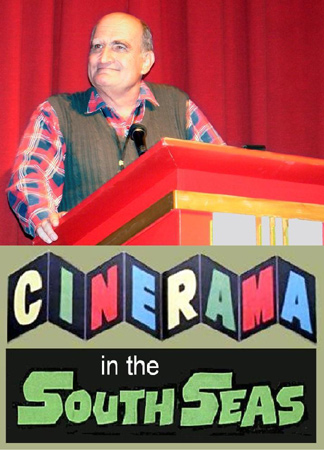 David
Coles from Australia David
Coles from Australia
Lecture by
David Coles featuring
behind-the-scenes anecdotes and stills relating to the production and
release of the fifth Cinerama travel title.
Two years ago David Coles travelled from Australia to give us a one hour
behind-the-scenes history of Cinerama's Oyster Bay production facility.
This year he returns to join our 60th Anniversary Tribute with another
quirky Powerpoint presentation.
David has had a unique opportunity, denied others over the last 45
years, of being able to see and study the only surviving print of the
5th travel title "Cinerama South Seas Adventure" (1958) [Thanks to
John H. Mitchell who
lives in a neighbouring Sydney suburb].
As the production unit was based in Sydney for half the shoot, there
were many local people to trace who had anecdotes about their
involvement in various aspects of the production. No matter how obscure
or trivial, David was keen to seek out every minute detail.
What happened to the camera in the surf at Bondi Beach, and how was it
saved? Did the Cinerama plane fly under the Harbour Bridge? What did the
Te Vega's captain have to do with the first anamorphic widescreen film
released in 1953? (A lot actually - he photographed it!) What was the
strange relationship between the actor playing the French artist looking
for romance in the South Seas and the beautiful Tahitian dancer Ramine?
Did Elvis Presley really try to stop the filming?
David brings us up to speed on who was who, and what to look out for as
the film unfolds. He examines the whys and wherefores of how it was all
put together and released.
The presentation contains dozens of never before seen behind-the-scenes
photos, and is intended to enhance the enjoyment and appreciation of the
production for Cinerama fans about to enjoy the South Seas for the first
time, and those revisiting the locale after half a century.
David would particularly like to thank both
John H. Mitchell and
Dave
Strohmaier for their generous assistance in making this project
possible.
Who is David Coles?
|
Magnified Grandeur
| |
"South Seas Adventure" - 12:30
"Presenting the World Premiere
of the new, digitally remastered, recombined and Smileboxed® motion
picture, which was scanned off of the original camera negatives, and
will be presented in a 2K digital format."
|
|
 12:30 – 14:51 “South Seas Adventure”
(2:06) + 15 intermission.
Filmed in:
3x35mm 6 perforations, 26 frames per second.
Principal photography in: Cinerama. Presented on:
The curve in Cinerama. Smileboxed and remastered with 5.1 digital stereo.
Angle of view:
146°. Country of origin: USA. Production year:
1957.
World Premiere: 15.07.1958, USA. 12:30 – 14:51 “South Seas Adventure”
(2:06) + 15 intermission.
Filmed in:
3x35mm 6 perforations, 26 frames per second.
Principal photography in: Cinerama. Presented on:
The curve in Cinerama. Smileboxed and remastered with 5.1 digital stereo.
Angle of view:
146°. Country of origin: USA. Production year:
1957.
World Premiere: 15.07.1958, USA.
Directed by: Carl Dudley, Richard Goldstone, Francis D. Lyon, Walter
Thompson, Basil Wrangell. Written by: Charles Kaufman, Joe Ansen, Harold
Medford. Produced by: Carl Dudley, Richard Goldstone. Original Music by:
Alex North. Cinematography by: John F. Warren.
Diane Beardmore (Kay Johnson),
Marlene Lizzio (Marlene Hunter),
Tommy Zahn (Ted Hunter), Igor Allan (Jean-Louis Martin), Ed Olsen (Amos
Dorn, skipper of the Te Vega), Walter Gibbons-Fly (Oley, the engineer),
Fred Bosch (Pete, the cook),
Ramine (Turia), Jay Ashworth (Jim Perry), Maxine Stone (Nurse), Don
Middleton (Nurses Husband), Hans Farkash (Stefan Koschek), Janice Dinnen
(Anna Koschek), Eric Reiman (David Koschek), Sean Scully (Bobby Koschek),
Margaret Roberts (Betty Koschek), Mrs Gibb, Frank Basden, Dr Huxtable,
Vic Cover.
Introduced by Randy Gitsch and Dave Strohmaier
| |
2012 restoration
|
|
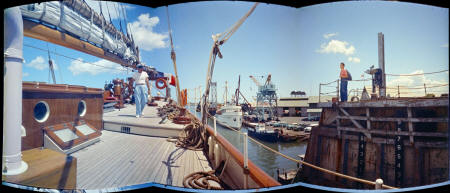 Combined Frame from South Seas Adventure,
The Te Vega at Port. Combined Frame from South Seas Adventure,
The Te Vega at Port.
Restoration Supervised by David Strohmaier. Producer: John Sittig.
Co-producer: Tom H. March.
Associate Producer: Randy Gitsch and Carin-Anne Strohmaier. Post
Production Consultant: Philip Hodgetts. Seven channel Cinerama Sound
transferred by Chace Audio by Deluxe. Sound transfer by Thom Piper, Jr.
& Paul Gilbert. Cinerama Sound remastered by Gregory Faust. Special 6
perf film scanning and image restoration by Image Trends, featuring
special processing with Digital Ice. Image Trends president & CEO: Dan
Sullivan. Image Trends CTO & algorithm invention: Al Edgar. Image Trends
PE lead engineer alignment & restoration: Michael Wilder. Image Trends
quality control data management & process scheduler: Amanda Cook.
Thanks:
David Coles. Special thanks (2012 restoration):
Carol Dudley Katzka,
Family of Carl Dudley,
Gregory Lukow, The Library of Congress Packard Campus for Audio Visual
Conservation,
John H. Mitchell,
Larry Smith
Scanning Cinerama Films
|
in70mm.com's Cinerama page
| |
“Cinerama South Seas Adventure” proved
to be the 5th and last of the original, 3-panel Cinerama travelogues.
Released in 1958, and 4 months after the 3-panel competitor, “Windjammer:
The Voyage of the Christian Radich”, it is at moments similar, although
overall an entirely different tale than previously seen in the format. Five
separate stories are woven out of a theoretical voyage that starts enroute
to Hawaii, and after traversing the south seas as far as Australia, ends up
flying back home from Honolulu.
Unseen since the early 1970’s the picture, now remastered from it’s original
camera negatives, shines bright emitting both a panorama that is at times
breathtakingly colorful, as well as a fascinating time capsule of 1950’s
innocence and quaintness. With a rousingly superb score by Alex North, and
part narration by Orson Welles, the picture also, surprisingly may be the
first to chronicle primitive bungee jumping.
This remaster is the original roadshow version of the picture, complete with
overature, intermission and exit music. Randy Gitsch
| |
"Ryan's Daughter" - 15:15
|
|
  "Ryan's
Daughter"
(3:26 + intermission).
Filmed in: 65mm 5 perforations, 24 frames per second.
Principal photography in:
Super Panavision 70. Presented:
on the flat screen in
Super Panavision 70 with 6-track magnetic stereo.
Aspect ratio: 2,21:1. Country of origin: USA. Production year: 1970.
World Premiere: 09.11.1970 Ziegfeld, NYC; USA. UK Premiere:
09.12.1970, Empire, London. "Ryan's
Daughter"
(3:26 + intermission).
Filmed in: 65mm 5 perforations, 24 frames per second.
Principal photography in:
Super Panavision 70. Presented:
on the flat screen in
Super Panavision 70 with 6-track magnetic stereo.
Aspect ratio: 2,21:1. Country of origin: USA. Production year: 1970.
World Premiere: 09.11.1970 Ziegfeld, NYC; USA. UK Premiere:
09.12.1970, Empire, London.
Directed by David Lean. Written by Robert Bolt.
Produsced by Anthony Havelock-Allan. Music by Maurice Jarre.
Cinematography by Freddie Young. Edited by Norman Savage
Robert Mitchum (Charles Shaughnessy), Trevor Howard (Father
Collins), Christopher Jones (Randolph Doryan), John Mills
(Michael), Leo McKern (Thomas Ryan), Sarah Miles (Rosy Ryan),
Barry Foster (Tim O'Leary)
Movie poster art by
Howard Terpning
"Ryan's
Daughter" reprinted in 70mm
| |
 Academy
Awards Academy
Awards
Best Actor in a Supporting Role - John Mills
Best Cinematography - Freddie Young
Also Nominated for
Best Actress in a Leading Role - Sarah Miles
Best Sound - Gordon McCallum, John Bramall
"Ryan's
Daughter"
Revisited
|
On the trail of
"Ryan's Daughter"
|
School House
|
There
Were Giants in the Land
|
The
Importance of Panavision
|
Takuo "Tak"
Miyagishima of Panavision Passed Away
|
|
"The Wonderful World of Brothers Grimm" -
20:00
|
|
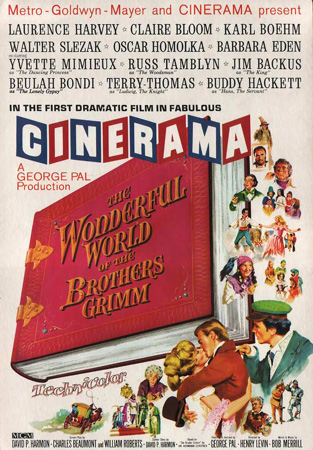 “The
Wonderful World of the Brothers Grimm”
(2:15) + intermission.
Filmed in:
3x35mm 6 perforations, 24 frames per second.
Principal photography in: Cinerama. Presented:
On the curved
screen in
3-strip “The
Wonderful World of the Brothers Grimm”
(2:15) + intermission.
Filmed in:
3x35mm 6 perforations, 24 frames per second.
Principal photography in: Cinerama. Presented:
On the curved
screen in
3-strip
 with 7 track
magnetic stereophonic sound.
Angle of view: 146°. Country of origin: USA. Production year:
1961.
World Premiere: 07.08.1962, USA.
with 7 track
magnetic stereophonic sound.
Angle of view: 146°. Country of origin: USA. Production year:
1961.
World Premiere: 07.08.1962, USA.
Directed by Henry Levin. Produced by George Pal. Original Music
by Leigh Harline. Cinematography by Paul Vogel. Film Editing by
Walter Thompson. Written by: David P. Harmon, Charles Beaumont
and William Roberts
Laurence Harvey (Wilhelm Grimm), Karlheinz Böhm (Jacob Grimm),
Claire Bloom (Dorothea Grimm), Yvette Mimieux (The Princess),
Russ Tamblyn (The Woodsman), Terry-Thomas (Ludwig) ('The Singing
Bone')
"The Wonderful
World of Brothers Grimm" soundtrack released by Film Score
Monthly
|
in70mm.com's Cinerama page
|
Interview with
John H. Mitchell, Australia
| |
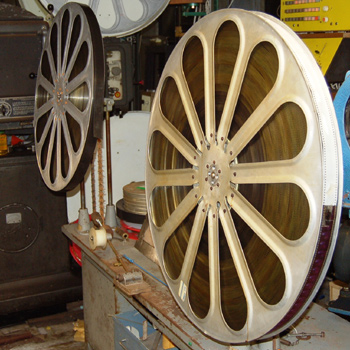 Right
reel: "This IS of course, the Model 34", well, not really. It's an
optical illusion. Both reels are the smaller version. Image by
"Dr. Cinerama", alias David Coles. Right
reel: "This IS of course, the Model 34", well, not really. It's an
optical illusion. Both reels are the smaller version. Image by
"Dr. Cinerama", alias David Coles.
Bradford will be the first public
3-strip screening of "Grimm" for 40 years. It played a
revival season at the Paris
Empire March 22,1972 to June 8,
1972. There MAY have been later showings (possibly in Spain) but
I have not yet found the evidence for them. Also of interest is
the fact that "Grimm" was cut to a precise maximum
running time of 135 minutes. It was determined that the original
'7,500 foot' spools could hold up to 62 minutes at the original
26 fps. At the slower speed of 24 fps this running time
increases to 67½ minutes (half of 135). At the time of its
release in August 1962 the need for larger reels for "HTW3"
had already been determined, and venues were progressively being
upgraded for the larger '10,000 foot' 34 inch reels, but the
limit on "Grimm" had been set sometime earlier. As
evidence of this, the enclosed John H. Mitchell photo taken
recently is of Parts I and II of "Grimm" on the smaller
size (30½ inch diameter) reels. Part One on the left is full to
overflowing, as you would expect at over 9,500 feet !!! David
Coles
|
|
Sunday 29.04.2012
|
|
Cinerama! Cinerama! - 10:00
|
|
 New
3-strip print of "Renault Dauphine" commercial with a 5 min intro
mention academy so RT would be 10 minutes. New
3-strip print of "Renault Dauphine" commercial with a 5 min intro
mention academy so RT would be 10 minutes.
..in Cinerama
"Renault Dauphine" Tentative shooting script
John Harvey 13 minute short on
New Neon
John H. Mitchell
Tribute for his work on Cinerama
Scenes not in "Cinerama Adventure" - Mona lisa, Cuba etc. with intros
Audience on Stage
Widescreen Academy
| |
“From Biograph to Fox Grandeur. Early
Experiments in Large Format Presentations”
Lecture by Kevin Brownlow
- 13:00
|
|
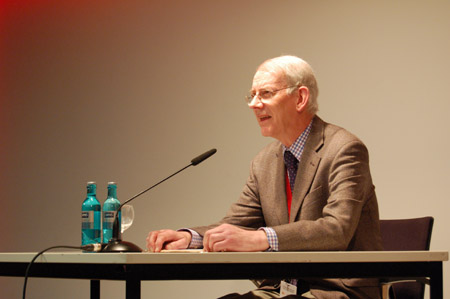 Legendary
Film Historian and preservationist Kevin
Brownlow during a lecture. Image by Thomas Hauerslev Legendary
Film Historian and preservationist Kevin
Brownlow during a lecture. Image by Thomas Hauerslev
We are delighted that historian and preservationist
Mr. Kevin
Brownlow of Photoplay Productions has accepted our invitation to come and give a lecture.
Mr. Brownlow has recently (2010) been awarded an Academy Award (OSCAR) - The Honorary Award, an Oscar® statuette, is given to an individual for “extraordinary distinction in lifetime achievement, exceptional contributions to the state of motion picture arts and sciences, or for outstanding service to the Academy.”
As a film editor, Brownlow worked on Tony Richardson's "The Charge of the
Light Brigade" (1968). With Andrew Mollo, he directed two feature films,
"It Happened Here" (1964) and "Winstanley" ( 1975).
In 1980, with David Gill, he directed for Thames TV a 13-part TV series
devoted to the American silent film. In 1980, his five-hour restoration
of Abel Gance "Napoleon" was presented with a score composed by Carl
Davis. Following the demise of Thames TV, Brownlow and Gill formed their
own company, Photoplay Productions, with Patrick Stanbury. Their
restorations included the Valentino classic, "THE FOUR HORSEMEN OF THE
APOCALYPSE" (1921).
In 1995, they completed the six-part CINEMA EUROPE to mark the centenary
of cinema.
David Gill died in 1997. Brownlow and Stanbury continued the tradition
with documentaries like CECIL B DEMILLE – AMERICAN EPIC and I’M KING
KONG, the career of Merian C Cooper, for TCM.
Kevin Brownlow
Interview - Part 1 and
Part 2
|
Kevin Brownlow visits
the Schauburg in Karlsruhe
|
|
"Around the World in 80 Days" - 14:00
|
|
  "Around
the World in 80 Days" / "In 80 Tagen um die Welt" (German)
/ "Le Tour du Monde en 80 Jours" (French) (3:03) +
intermission. Filmed
in: 65mm 5 perforations, 30 frames per second. Principal
photography in: Todd-AO. Presented: on the curved
screen in Todd-AO, with
6-track magnetic stereo. Aspect ratio: 2,21:1. Country
of origin: USA. Production year: 1955. World
Premiere: Rivoli, New York, USA 17.10.1956–05.10.1958.
German premiere: 04.10.1957. "Around
the World in 80 Days" / "In 80 Tagen um die Welt" (German)
/ "Le Tour du Monde en 80 Jours" (French) (3:03) +
intermission. Filmed
in: 65mm 5 perforations, 30 frames per second. Principal
photography in: Todd-AO. Presented: on the curved
screen in Todd-AO, with
6-track magnetic stereo. Aspect ratio: 2,21:1. Country
of origin: USA. Production year: 1955. World
Premiere: Rivoli, New York, USA 17.10.1956–05.10.1958.
German premiere: 04.10.1957.
Directed by Michael Anderson. Produced by Michael Todd. Written
by James Poe, John Farrow and S.J. Perelman. Music by Victor
Young. Photographed by Lionel Lindon. Edited by Howard Epstein
and Gene Ruggiero
 David Niven (Phileas Fogg), Cantinflas (Passepartout), Robert
Morley (Ralph), Noel Coward (Hesketh-Baggott), John Gielgud (Mr.
Foster), Trevor Howard (Denis Fallentin), Fernandel (French
Coachman), Charles Boyer (Monsieur Gasse), Evelyn Keyes (The
Flirt), Cesar Romero (Achmed Abdullah's Henchman), Robert Newton
(Mr. Fix), Ronald Colman (Railway Official), Shirley MacLaine
(Princess Aouda), Peter Lorre (Steward), George Raft (Saloon
Bouncer), Red Skelton (Drunk in Saloon), Marlene Dietrich
(Saloon Hostess), John Carradine (Col. Proctor Stamp), Frank
Sinatra (Saloon Pianist), Buster Keaton (Train Conductor), Joe
E. Brown (Stationmaster) and many more David Niven (Phileas Fogg), Cantinflas (Passepartout), Robert
Morley (Ralph), Noel Coward (Hesketh-Baggott), John Gielgud (Mr.
Foster), Trevor Howard (Denis Fallentin), Fernandel (French
Coachman), Charles Boyer (Monsieur Gasse), Evelyn Keyes (The
Flirt), Cesar Romero (Achmed Abdullah's Henchman), Robert Newton
(Mr. Fix), Ronald Colman (Railway Official), Shirley MacLaine
(Princess Aouda), Peter Lorre (Steward), George Raft (Saloon
Bouncer), Red Skelton (Drunk in Saloon), Marlene Dietrich
(Saloon Hostess), John Carradine (Col. Proctor Stamp), Frank
Sinatra (Saloon Pianist), Buster Keaton (Train Conductor), Joe
E. Brown (Stationmaster) and many more
| |
Academy Award winner:
Best Cinematography, Color Lionel Lindon
Best Film Editing Gene Ruggiero & Paul Weatherwax
Best Music, Scoring of a Dramatic or Comedy Picture Victor Young
(Posthumously)
Best Picture Michael Todd
Best Writing, Best Screenplay - Adapted James Poe, John Farrow,
S.J. Perelman
Academy Award Nominated:
Best Art Direction-Set Decoration, Color, James W. Sullivan, Ken
Adam, Ross Dowd
Best Costume Design, Color Miles White
Best Director Michael Anderson
Cinestage in London
|
"Around the World in 80 Days" 70mm Seasons
|
Todd-AO films
|
The Saga of Todd-AO
| |
"Cinerama Adventure" - 17:30
|
|
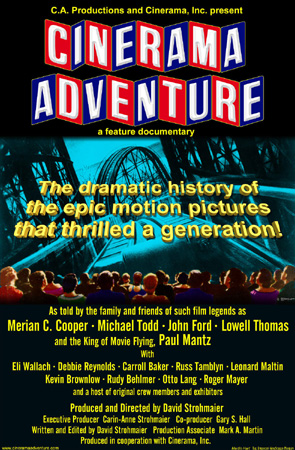 “Cinerama Adventure”
(1:37).
Filmed in: video, 25 frames per second.
Principal photography in: all sorts of video formats. Presented in:
On the flat screen in 35mm Dolby Digital.
Aspect ratio: 1,75: 1 - 1,85:1. Country of origin: USA. Production year:
2003.
World Premiere: 22.08.2003 - 28.08.2003, Arclight Hollywood, Los Angels, USA
(Academy Award qualifying run). “Cinerama Adventure”
(1:37).
Filmed in: video, 25 frames per second.
Principal photography in: all sorts of video formats. Presented in:
On the flat screen in 35mm Dolby Digital.
Aspect ratio: 1,75: 1 - 1,85:1. Country of origin: USA. Production year:
2003.
World Premiere: 22.08.2003 - 28.08.2003, Arclight Hollywood, Los Angels, USA
(Academy Award qualifying run).
Produced, written and edited by: Dave Strohmaier. Produced by: Randy
Gitsch. Original Music by William Stromberg & John Morgan. Camera: Gerald Saldo and many
others.
Debbie Reynolds, Carroll Baker, Eli Wallach, Louis de Rochemont III,
Michael Todd Jr., and Russ Tamblyn (as
themselves).
Complete Credits
THE CINERAMA ADVENTURE is a 96 minute documentary celebrating the long
lost three-camera three-projector cinematic process which thrilled
millions of baby boomers around the globe in the 1950s and early 60s.
Though abandoned in 1966, the Cinerama process still brings back fond,
and sometimes passionate, memories to millions of Baby Boomers - of
sweeping aerials, world travel, thrilling roller coaster rides, and
other virtual reality experiences designed to lift the audience out of
their theatre seats and into the action.
| |
Using unusual film clips that have not been seen for over 40 years, "Cinerama Adventure" will take you behind the scenes for the human
interest stories of the trials ans triumphs that were involved in making
theses films: stories of hair rasing danger, international intrigue,
critical injury and death.
"Cinerama Adventure" is a dramatic and nostalgic look back at forgotten
era in film history. Cinerama forever changed the way we see and hear
movies and single handedly thrust the entire film industry into the wide
screen stereo sound era that is with us to this day.
Visit the official
website
and on
imdb.com
Introduced by Dave Strohmaier and Randy Gitsch
|
|
"Samsara" - 19:45
|
|
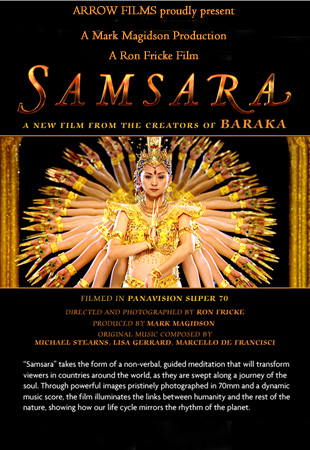 “Samsara”
(1:40).
Filmed in: 65mm, 24 frames per second.
Principal photography in: Panavision System 65. Presented in:
4k DCP Panavision Super 70 in Dolby Surround 7.1 with full PCM sound, on the flat screen.
Aspect ratio: 2,21:1. Country of origin: USA. Production year:
2011.
World Premiere: 11.09.2011, Toronto Film Festival, Canada. UK
Premiere: 29.04.2012 “Samsara”
(1:40).
Filmed in: 65mm, 24 frames per second.
Principal photography in: Panavision System 65. Presented in:
4k DCP Panavision Super 70 in Dolby Surround 7.1 with full PCM sound, on the flat screen.
Aspect ratio: 2,21:1. Country of origin: USA. Production year:
2011.
World Premiere: 11.09.2011, Toronto Film Festival, Canada. UK
Premiere: 29.04.2012
"Samsara"
to Premiere in Canada, September 11, 2011
|
"Samsara" is a
Triumph of the Moving Image
|
A Conversation with Mark
Magidson and Ron Fricke
|
"Samsara" a 70mm
film project by Ron Fricke
|
Super
Panavision 70
|
The
Importance of Panavision
|
Takuo "Tak"
Miyagishima of Panavision Passed Away
|
|
|
|
|
Monday 30.04.2012
|
|
"The Star Chamber" - 10:00
|
|
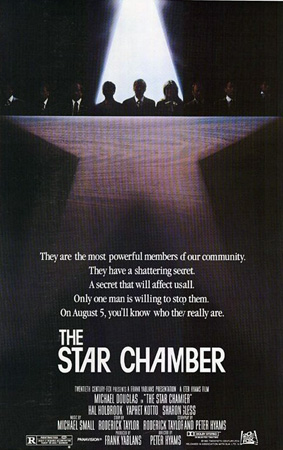 "The
Star Chamber"
(1:49).
Filmed in:
35mm, 4 perforations, 24 frames per second.
Principal photography in: Panavision. Presented on:
The flat screen in a vintage 70mm print with 6-track magnetic Dolby
Stereo.
Aspect ratio: 2,21:1. Country of origin: USA. Production year:
1983
World Premiere: 05.08.1983, USA "The
Star Chamber"
(1:49).
Filmed in:
35mm, 4 perforations, 24 frames per second.
Principal photography in: Panavision. Presented on:
The flat screen in a vintage 70mm print with 6-track magnetic Dolby
Stereo.
Aspect ratio: 2,21:1. Country of origin: USA. Production year:
1983
World Premiere: 05.08.1983, USA
Plot
|
Films
blown up to 70mm
|
70mm Blow Up List 1983
|
The
Importance of Panavision
| |
"Black Rain" - 12:30
|
|
 "Black
Rain"
(2:05).
Filmed in:
35mm, 4 perforations, 24 frames per second.
Principal photography in: Panavision. Presented on:
The flat screen in a vintage 70mm print with 6-track magnetic Dolby Stereo
SR.
Aspect ratio: 2,21:1. Country of origin: USA. Production year:
1989
World Premiere: 22.09.1989, USA "Black
Rain"
(2:05).
Filmed in:
35mm, 4 perforations, 24 frames per second.
Principal photography in: Panavision. Presented on:
The flat screen in a vintage 70mm print with 6-track magnetic Dolby Stereo
SR.
Aspect ratio: 2,21:1. Country of origin: USA. Production year:
1989
World Premiere: 22.09.1989, USA
Plot
|
Films
blown up to 70mm
|
70mm Blow Up List 1989
|
The
Importance of Panavision
|
|
|
|
|
Go: back - top - back issues - news index
Updated
22-01-25 | |
|
|